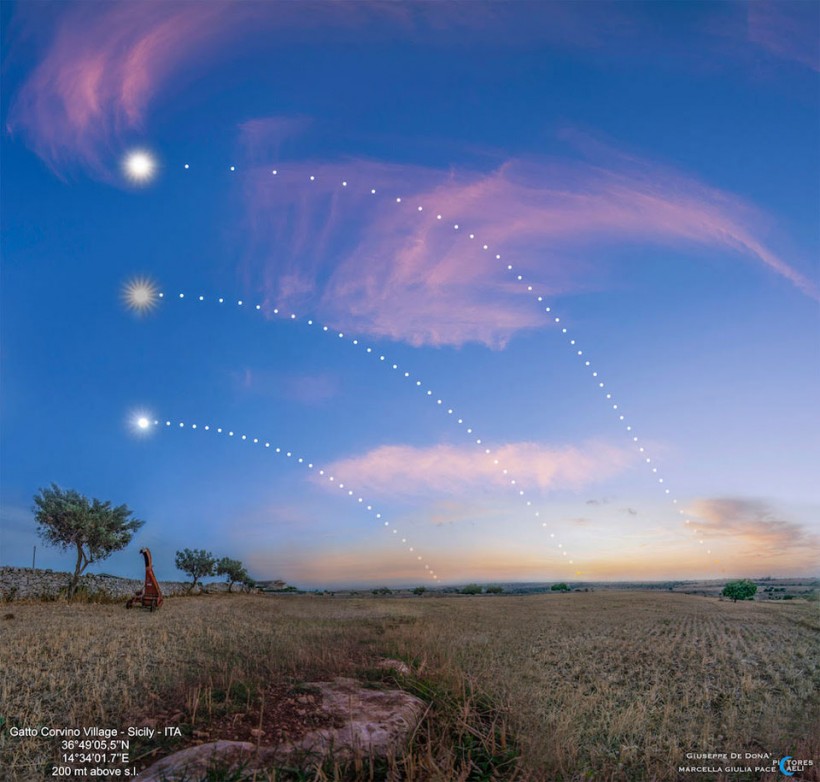NASA has recently showcased a captivating image titled "Three Sun Paths," highlighting the ever-changing trajectory of the Sun across the sky.
The photograph, taken near Gatto Corvino Village in Sicily, Italy, captures the Sun's arc from noon to sunset on three significant days: the summer solstice, equinox, and winter solstice. This mesmerizing image visually represents how the Sun's path varies throughout the year.

The Sun's 3 Paths
Photographers Marcella Giulia Pace and Giuseppe De Donà captured the Sun's journey, revealing its distinct paths during different seasons. The photograph serves as a reminder that the length and shape of the Sun's path play a crucial role in determining the Earth's seasons, rather than the planet's proximity to the Sun.
Contrary to popular belief, the Earth's distance from the Sun does not solely dictate the seasons. Instead, the Sun's path and the duration it spends in the sky during each season are more significant factors.
This image beautifully illustrates this phenomenon, showcasing the Sun's longer path during the summer solstice, shorter path during the winter solstice, and an intermediate path during the equinox.
The captivating photograph captures the Sun's dynamic journey and sheds light on the Earth's annual orbit around its star. It serves as a stunning visual representation of the intricate relationship between our planet and the Sun, influencing the natural cycles and the changing of seasons.
Today, as we experience a solstice, it marks a pivotal moment in the Sun's path. In the Earth's northern hemisphere, the Sun embarks on its longest path across the sky, symbolizing the peak of summer. Meanwhile, in the southern hemisphere, the Sun takes its shortest path, representing the height of winter.
By featuring this remarkable image, NASA aims to inspire a sense of wonder and curiosity about the natural world and the celestial bodies that shape our lives. It serves as a visual testament to the continuous motion and ever-changing nature of our universe.
Read Also: NASA Releases Picture of Mythical Bird Outlined in the Milky Way
NASA Picks 5 Experiments for 2024 Total Solar Eclipse
In related news, NASA has chosen five interdisciplinary science projects to study the Sun, Earth, and their interactions in preparation of for the upcoming total solar eclipse on April 8, 2024.
One of the projects, led by Amir Caspi from the Southwest Research Institute, plans to capture images of the eclipse from NASA's WB-57 high-altitude research aircraft flying at an altitude of 50,000 feet.
Another project, led by Shadia Habbal from the University of Hawaii, will employ cameras and spectrometers aboard NASA's WB-57s to investigate the temperature, chemical composition, and coronal mass ejections of the Sun's corona.
Amateur radio operators will also play a role in the scientific endeavors during the eclipse. Nathaniel Frissell from The University of Scranton is organizing a "Solar Eclipse QSO Party" where ham radio operators will attempt to make radio contacts with operators in different locations.
Bharat Kunduri from the Virginia Polytechnic Institute & State University will leverage the Super Dual Auroral Radar Network (SuperDARN) to study the impact of solar radiation on Earth's upper atmosphere during the eclipse.
Lastly, Thangasamy Velusamy from NASA's Jet Propulsion Laboratory, educators, and citizen scientists will observe solar "active regions" using the Goldstone Apple Valley Radio Telescope (GAVRT).
Related Article: [WATCH] NASA Visualizes Carbon Emissions Driving Climate Change on Earth










